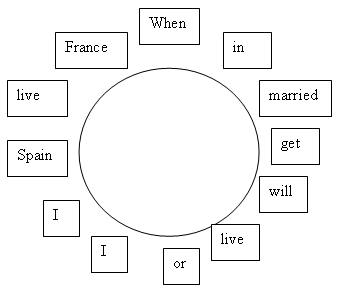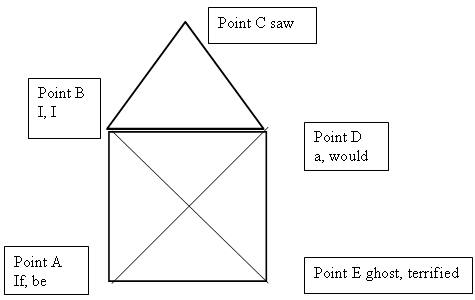Editorial
This article was first published in Modern English Teacher, October 2005 Vol. 14/4
Playing With Sentences
Simon Mumford, Turkey
Simon Mumford teaches EAP at Izmir University of Economics, Turkey. He has written on using stories, visuals, drilling, reading aloud, vocabulary and is especially interested in the creative teaching of grammar. E-mail: simon.mumford@ieu.edu.tr
Menu
Introduction
Find the main verb
Possible or impossible
Work it out
Swapping words around
Sentence story
Sentence clock
Threes
Silent sentences
Buying words
Sentence puzzle
Conclusion
Most teachers know word games but sentence-level games are rarer. However, students can have as much fun with the order of words in sentences as they can with the order of letters in words. In fact, as grammar is in many ways more complex than spelling, the limited number of choices will help students to draw on their linguistic knowledge to play with sentences. Here are some ideas.
Write a sentence of seven to nine words, which contains only one main verb. Draw a blank for each word and number each one. Tell the students they have to find the main verb in four guesses. As they call out numbers, write the word for those numbers in the blank. As more words are revealed, it should help them decide where the main verb is. If they find it in four guesses they have won, if not, the teacher wins.
Think of a sentence, for example: ‘If it rains tomorrow, we will definitely stay at home. ’ Write the words on the board, mixed up.
| If at will home we rains it definitely tomorrow stay |
Tell students they have to find pairs of words that go together, eg ‘at+ home’, ‘it + rains’ ‘stay+tommorrow’ can go together, but ‘we+rains’ and ‘if+will’ ‘we+home’ would not be found consecutively in a sentence. Put the class in two teams and ask them, in turn, to give combinations. Give them one point for each possible combination, take one point off if the combination suggested is impossible. The winning team (the first to get five) can be asked to guess the whole sentence. The rationale for this is to get students to consider the possibilities of word combinations before guessing the whole sentence.
Think of a sentence, eg ‘He really should not have gone to the party by himself. ’
Write the words mixed up on the board:
| to should gone really party himself have he by not the |
Draw a numbered line on the board for each word of the sentence and tell the students to guess the words. They call out a word and the position they think it could be, eg ‘3-by’ ‘1-the’ ‘5-have’. If they are right, write the word in the space. If they are wrong, write the word under the space and put a line through it, as in the example below.

After eight guesses, they should have enough information to attempt to guess the whole sentence.
Think of a sentence, for example:‘ My wife’s brother has been abroad many times. ’
Now mix the words up and write them on the board, as in (1)
- My many brother wife’s times been has abroad
- My wife’s brother many times been has abroad
- My wife’s brother has times been many abroad
- My wife’s brother has been times many abroad
- My wifes’s brother has been abroad many times
The idea is to arrive at the correct sentence by asking students to change the position of two words each time by swapping them around. So, in this example, swapping ‘wife’ and ‘many’ as in sentence 2 would bring ‘wife’ into the correct position, but not ‘many’. However swapping ‘has’ and ‘many’ next time, as in 3 would put both those words in the right places. For the next move, exchange ‘times’ and ‘been’, as in 4, leaving one more swap (‘times’ and ‘abroad’) to complete the sentence, as in 5. Limit the number of swaps allowed to six for an eight word sentence. Make it easier by allowing students to see the original first.
Students listen to a story about a sentence and write it. Read the story:
‘One day there was a noun, ‘Jane’. She met a verb, ‘goes’. They liked each other and decided to make a sentence, and soon ‘park’, ‘the’, and ‘to’ joined them. When they got in the right order, they were a happy sentence. Then ‘yesterday’ joined on the end and the verb changed. ‘You’re different from before, you’ve changed’ Jane said to the verb. ‘Well, I had to when ‘yesterday’ came along’, said the verb. After a while they met another sentence, ‘She met her friend.’ They got on well so they decided to join into one big sentence. Everyone was happy except ‘She’, who was so angry about not being at the head of the sentence, she ran away. Fortunately, ‘and’ took her place, and they all lived happily together.’
If they have followed the story successfully, students should have written: ‘Jane went to the park yesterday and met her friend. ’

Write a sentence, with words in a random order, around a circle. Ask students to put the sentence in the correct order as follows: tell them the first word is at the top and then ask them to call out the next word. Give them clues if they need help: eg ‘forward, back a little, forward a long way, further/not so far...’ If you have a twelve word sentence you can say each word represents an hour, thus: ‘back one hour, forward three hours’. Alternatively ask students to write the instructions to make the sentence, which in this case would be: ‘start at ‘when’, forward 7, back 4, back 1, forward 6, back 4, forward 6, back 9, forward 8, back 3, forward 5’. The sentence is ‘When I get married, I will live in Spain or France. ’
Choose a long (twelve plus) word sentence, for example:‘ It was late when I got home last night, and everyone was asleep. ’ Write the words alternately in three boxes:

Put students in groups of three, number each student 1, 2 and 3. Then ask them to make the sentence by taking it in turns to say one word from their box. Encourage them to experiment until it sounds right. Leaving the capital letter on the first word will help them start.
Choose a sentence with eight words, eg I would rather swim than ride a horse. Put the students in pairs and give each pair a piece of paper with eight blanks. Each student has a piece of paper with four of the words in random order, so that between them the students have all the words, eg student 1 horse swim than I , and student 2 a would ride rather. They cannot show this piece of paper to each other, or speak to each other during the activity. The first student writes one of his words in pencil in one of the blanks, in the place where he thinks it fits, and passes the paper to the other student who does the same and passes it back, and so on until the sentence is complete. Players may rub words out and reposition them, if both partners agree, until a sentence is made, but this must be done with gesture.
Choose a sentence, eg ‘The big black dog has escaped from the garden. ’ Draw a blank for each word and write the word class for each word under the blank. So, for the above example, it would be:

Write the values of the words on the board as follows:
Articles: 5 points, prepositions 10 pts, adjectives/adverbs 15 points, nouns/ auxillary verbs 20 points, main verbs 25 points.
Tell the class that they start with 100 points credit. If they buy a main verb, write in ‘escaped’ in the appropriate blank and take 25 points off their credit, and so on. The aim is to guess the whole sentence before they run out of credit. Note credit is not enough to buy all words so they need to be careful!
Think of a nine word sentence such as ‘If I saw a ghost I would be terrified.’
Draw the house shape below on the board. Write the words of the sentence at the points so that it is possible to visit each word in sequence by joining the all points between the words to make the house diagram but without going over the same line twice or taking your pen off the diagram. (It has five points so write two words at each except C, which has only one). Challenge students to come to the board and make the sentence by joining the points with a pen. The answer is A, B, C, D, E, B, D, A, E. ‘If I saw a ghost, I would be terrified.’ It is also possible to reverse this sentence, B, D, A, E, A, B, C, D ,E.

These are some of the ways I have found of playing with sentences. Perhaps other teachers can find new ways, bearing in mind there seem to be two main techniques, revealing the words of a sentence one at a time, and showing the whole sentence in a mixed order. The addition of some kind of challenge will motivate the students to think about structure, draw on their grammatical knowledge and have fun at the same time.

The Creative Methodology for the Classroom course can be viewed here


|